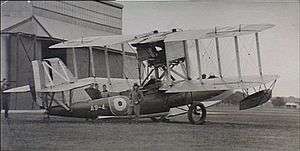Supermarine Seagull (1921)
| Seagull | |
|---|---|
 | |
| Australian Seagull III at RAAF Base Richmond circa. 1928 | |
| Role | Reconnaissance flying boat |
| Manufacturer | Supermarine |
| First flight | May 1921 |
| Primary users | Fleet Air Arm Royal Australian Air Force |
| Number built | 34 |
| Developed from | Supermarine Seal |
The Supermarine Seagull was a British amphibian biplane flying boat developed from the Supermarine Seal by the Supermarine company. The Seagull was constructed of wood. The lower wing was set in the shoulder position and had two bays. The engine was mounted in a nacelle slung from the upper wing and powered a four-blade propeller in tractor configuration. The fuselage had an oval cross-section and had a planing bottom with two steps.
Design and development
The prototype, which became known as the Seagull Mk I, was modified from an existing Supermarine Seal II in 1921. Only one aircraft was built. A Napier Lion II engine was fitted and there were modifications made to the nacelle.
Produced from 1922, the production aircraft, the Seagull Mk II, had a Napier Lion III engine, and these were supplied to the Air Ministry and Royal Navy. A total of 25 were built, although some of these were later modified.
The Seagull Mk III was the Australian version, built in 1925. These were similar to the Seagull II but with a Napier Lion V engine and radiators modified for tropical use. Six of these were supplied to the Royal Australian Air Force, and one other Seagull III was built for Japan.
One Seagull II was rebuilt and fitted with Handley-Page leading edge slots and twin fins and rudders in 1928. This was considered to be the Mark IV, although Supermarine never designated it as such. Three ex-service aircraft were later placed on the British Civil Register.
In 1930 work was started on a flying boat of similar size and layout but with a predominantly metal airframe, powered by a Bristol Jupiter IX engine in pusher configuration. First flown in 1933 This became known as the Seagull V and later as the Walrus.
Operational history
The type was used operationally as a fleet spotter by 440 (Fleet Reconnaissance) Flight, operating from HMS Eagle. They were superseded in 1925 by the Fairey IIId. The Seagull II was the first British aircraft to be catapult launched in 1925. The crew was normally three (Pilot, Observer, and Radio-Operator). The sole armament was a .303 in (7.7 mm) Lewis gun.
Nine Seagulls were bought by the Royal Australian Airforce in 1926 and 1927. These were used to carry out a photographic survey of the Great Barrier Reef.[1]
Operators
- Royal Australian Air Force received nine aircraft.
- Imperial Japanese Navy Air Service received one aircraft.
- Fleet Air Arm received 26 aircraft.
Surviving aircraft
- The Fleet Air Arm Museum owns the front hull of an unknown Seagull. It was in use until 1974 as a garden shed, and presented to the museum in exchange for a new shed. It is currently on long-term loan to Solent Sky, an air museum in Southampton.[2]
- The Royal Air Force Museum London had a Seagull V on display in their Battle of Britain hall until October 2016 after which it was moved into storage.[3]
Specifications (Seagull II)
Data from Supermarine Aircraft since 1914 [4]
General characteristics
- Crew: Three (pilot, wireless operator & observer)
- Length: 34 ft 6 in (10.51 m)
- Wingspan: 45 ft 11 in (13.99 m)
- Height: 13 ft 6 in (4.11 m)
- Wing area: 605 ft² (56.2 m²)
- Empty weight: 3,691 lb (1,674 kg)
- Loaded weight: 5,462 lb (2,477 kg)
- Powerplant: 1 × Napier Lion II 12-cylinder water-cooled W-block piston engine, 480 hp (358 kW)
Performance
- Maximum speed: 80 mph at sea level (70 knots, 129 km/h)
- Service ceiling: 9,000 ft (2,743 m)
- Endurance: 3½ hours
- climb to 3,000 ft (915 m): 6.8 min
Armament
Specifications (Seagull II)
Data from Thetford 1982, p.319
General characteristics
- Crew: Three (pilot, wireless operator and gunner)
- Length: 37 ft (11.28 m)
- Wingspan: 46 ft (14.02 m)
- Height: 14 ft (4.26 m)
- Wing area: 593 ft² (55.11 m²)
- Empty weight: 3,897 lb (1,768 kg)
- Loaded weight: 5,668 lb (2, 571 kg)
- Powerplant: 1 × Napier Lion III 12-cylinder water-cooled W-block piston engine, 450 hp (337 kW)
Performance
- Maximum speed: 108 mph at sea level (174 km/h)
- Rate of climb: 11 minutes to 5,000 ft (1524 m)
Armament
See also
- Related development
- Related lists
- Seaplanes and flying boats
- Aircraft of the: Japanese Navy · Fleet Air Arm · RNZAF and RNZN
References
- ↑ Brown 1972, p.27.
- ↑ "Supermarine Seagull". Solent Sky. Retrieved December 15, 2012.
- ↑ "Supermarine Seagull V". Royal Air Force Museum. Retrieved October 30, 2015.
- ↑ Andrews and Morgan 1987, p.81.
Bibliography
- Andrews, C.F.; Morgan E.B. (1987). Supermarine Aircraft since 1914. London: Putnam. ISBN 0-85177-800-3.
- Brown, David. "Supermarine Walrus I & Seagull V Variants". Aircraft in Profile, Volume 11. Windsor, Berkshire, UK: Profile Publications Ltd., 1972.
- Kightly, James and Wallsgrove, Roger. Supermarine Walrus & Stranraer. Sandomierz, Poland/Redbourn, UK: Mushroom Model Publications, 2004. ISBN 83-917178-9-5.
- Shelton, John (2008). Schneider Trophy to Spitfire - The Design Career of R.J. Mitchell (Hardback). Sparkford: Hayes Publishing. ISBN 978-1-84425-530-6.
- Thetford, Owen. British Naval Aircraft Since 1912. London: Putnam, 1982 (5th ed.) ISBN 0 370 30021 1
External links
![]() Media related to Supermarine Seagull (1921) at Wikimedia Commons
Media related to Supermarine Seagull (1921) at Wikimedia Commons